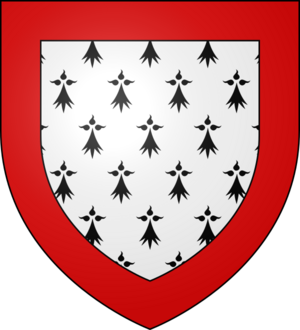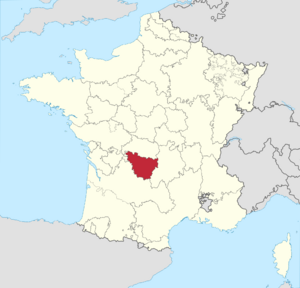History of Limousin facts for kids
The history of Limousin (called Lemosin in the local Occitan language) is very old. This area is one of the traditional regions of France. Its story goes all the way back to the time of the Celts and the Romans. Limousin is found in the western part of the Massif Central mountains, and it can get quite cold there in winter. The region is centered around the city of Limoges (or Limòtges).
The name Limousin comes from an ancient Celtic tribe called the Lemovices. These people lived here long ago. A very important place for the Lemovices, their main holy site, was recently discovered in a town called Tintignac. This discovery has become a huge deal for people who study Celtic history, as they found unique items like ancient musical instruments called carnyces there.
Early History of Limousin
Limousin has a deep connection to its ancient past. The Celtic tribe, the Lemovices, were skilled metalworkers and farmers. They built settlements and developed their culture in this region before the Romans arrived.
Roman Influence
When the Romans conquered Gaul (which included modern-day France), Limousin became part of their vast empire. The Romans built roads, towns, and introduced their way of life. Limoges, for example, grew into an important Roman city. The Roman presence helped shape the region's early development.
Limousin in the Middle Ages
After the Roman Empire declined, Limousin went through many changes. By the 10th century, the region was not a single, unified area. Instead, it was split into many smaller territories. These territories were called seigneuries, which were like small kingdoms ruled by powerful lords.
Important Territories
The most important of these smaller territories were in the southern part of Limousin. They were known as vicomtés, which means they were ruled by a type of noble called a viscount. Some of the most well-known vicomtés included:
- Limoges
- Comborn (located in what is now the Corrèze department)
- Ventadour (near modern-day Ussel and the Plateau de Millevaches)
- Turenne
The northern part of Limousin belonged to the County of La Marche. Also, the bishops of Limoges had control over much of what is now the Haute-Vienne area.
Castles and Conflict
Because Limousin was divided into so many small, independent areas, there was often competition and sometimes conflict between the different lords. This led to the building of many castles. These strong fortresses were used to defend territories and show the power of the local rulers. Today, you can still see the ruins of many of these old castles, which remind us of this time in history.
Richard the Lionheart
A famous event in Limousin's history happened in 1199. King Richard I of England, also known as Richard the Lionheart, was leading a siege against the Château de Châlus-Chabrol. This castle is about 30 kilometers (19 miles) southwest of Limoges. During this siege, King Richard was hit by a crossbow bolt and later died from his wound. This event is a significant part of the region's medieval story.
Modern Limousin
Limousin continued to evolve over the centuries. It remained a distinct region within France, known for its agriculture and beautiful landscapes.
Reforming the Region
In more recent times, during the Fifth Republic (which is the current system of government in France), the region of Limousin was officially put back together. This happened as part of efforts by the French government to give more power and responsibility to local regions, a process called decentralization. This helped Limousin to be recognized as a specific administrative region.
See also
- Limousin (province), the old province of France from before the French Revolution
- Limousin (administrative region), the former administrative region in southwest-central France



